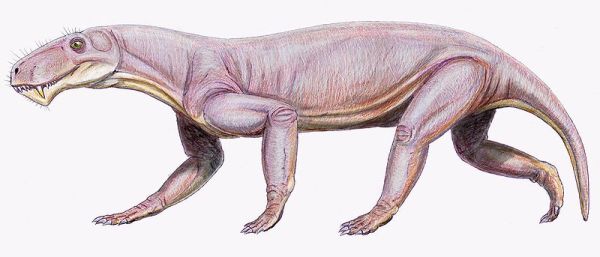
Artwork by Dmitry Bogdanov, GNU Free Documentation/Creative Commons Attribution license, Wikipedia
| Therapsida | ||
| The Vertebrates | Overview |
| Vertebrates Home | Vertebrate | Vertebrate |
Abbreviated Dendrogram
Synapsida
│
└─Therapsida
├─Raranimus
└─┬─Biarmosuchia
└─┬─Dinocephalia
│ ├─Anteosauria
│ └─Tapinocephalia
└─┬─Anomodontia
│ ├─Venyukovioidea
│ └─Dicynodontia
└─Theriodontia
├─Gorgonopsia
└─┬─Therocephalia
└─Cynodontia |
Contents
Index |
 |
| The late Permian therapsid Lycaenops, a typical gorgonopsid. This animal was about the size of, and a large dog. It may have been covered in fur, and hence at least partially warm-blooded. Artwork by Dmitry Bogdanov, GNU Free Documentation/Creative Commons Attribution license, Wikipedia |
The Therapsids were one of the great success stories of the Permo-Triassic. First appearing in the middle or even the early (if Tetraceratops is a member of this group) Permian, they very quickly dominated terrestrial and semi-aquatic environments, filling a number of ecological niches and guilds, including felid, canid, bear, otter, ungulate, and even mole analogues, as well as many forms with no contemporary counterparts. In keeping with the episodic nature of synapsid evolution, there seem to have been at least two distinct dynasties, a middle Permian fauna dominated by dinocephalians and other primitive forms, and a late Permian fauna characterised by a wide range of more advanced carnivorous and herbivorous groups. These animals were so abundant (especially the herbivorous yet bizaarely specialised dicynodonts with their toothless beaks) that one could easily refer to this period as the age of therapsids, with both anapsid reptiles and relict pelycosaurs playing second fiddle. Their evolutionary success was unfortunately cut short by the end Permian extinction event, and although a number of lineages made it through to the Triassic, their protomammalian metabolism put them at a disadvantage in a hot dry Triassic world far more suited to sauropsid reptiles, and increasingly dominated by thecodontian archosaurs. They survived by becoming progressively smaller and more mammal-like, except for the dicynodonts which if anything became larger. By the time the dinosaurs had appeared, the therapsids had given rise to the first mammals, although one lineage of rodent-like, non-mammalian therapsids, the tritylodonts, would continue to the Middle Cretaceous. MAK120127
page MAK120127